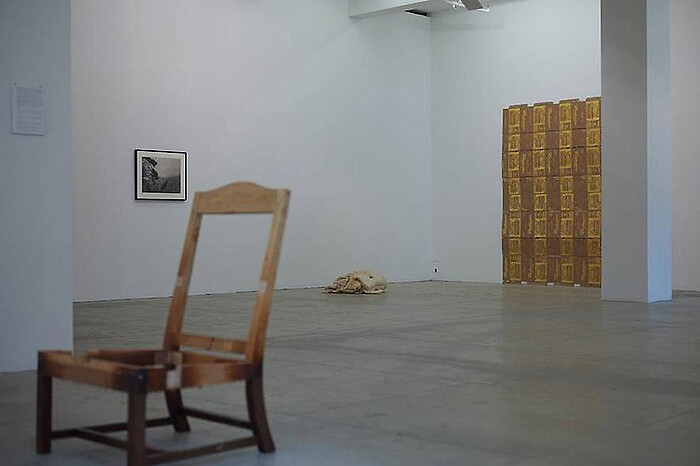The plush trappings of power, stripped down and isolated: this seems to be one of the themes and strategies of Danh Vo’s show “Mother Tongue” at Marian Goodman Gallery. The title comes from a small calligraphic drawing by the artist’s father, Phung Vo, who, while not knowing the language he writes in, inscribes Gothic stenciled letters on this and various other objects, such as gilded cardboard boxes of Budweiser (Promised Land, 2013). While there are a smattering of works represented in this diverse show, the dominant centerpiece is a quasi-archeological project displaying “finds” from a recent Sotheby’s auction of Robert McNamara’s belongings. Acquired by Vo and Marian Goodman, these objects have now found a new home in the art world, functioning both as political history and contemporary art.
Unlike the show’s title, the McNamara work seems to be less about translation or a mother tongue than about the looming presence of a domineering father. Bureaucratic relics used by the former U.S. Secretary of Defense during the Vietnam War have been either strewn about the two larger gallery spaces, or crisply displayed in backlit vitrines along the narrow corridor connecting the two galleries. This latter setup and its artifacts are the most visually and conceptually compelling, emitting a soft and variegated glow. The details? A carbon copy of McNamara’s letter to President Kennedy on Ford Co. letterhead laying out his conditions for accepting the government position; letters from Jacqueline Kennedy asking for McNamara’s help in planning her trip to Cambodia in 1967; a delicate little map detailing his trip to Vietnam in 1962; decapitated fountainhead pens displayed like entomological specimen; the point of a Middle Eastern bronze spear, part of a diplomatic gift from the former head of the Israeli Defense Forces Moshe Dayan; and a wooden Baule mask from the Ivory Coast, a keepsake from McNamara’s time as president of the World Bank.
The objects in the main gallery spaces are also administrative tokens from this recent auction. There is a vista of Yosemite taken by Ansel Adams, and a Vietnamese carved ivory tusk affixed to the gallery wall with its curvature menacingly pointing outward and up. The figure on the tusk is Ông Tho, the god of longevity, which if displayed upright would lean forward in serene contemplation, but as displayed here becomes priapic. But Vo gets the most mileage out of the two Chippendale-style chairs formerly used by McNamara and President Kennedy (gifts from Mrs. Kennedy shortly after her husband’s assassination). The cushy luxurious chairs have been taken apart, with each component material separated out into different positions in the gallery (and please, don’t say deconstructed—the gesture does not go far enough for that). Black leather coverings hang in a loose stack on the wall, horsehair stuffing and twine lie scattered on the floor, and the wooden skeletons of the chairs are poised in the gallery, naked.
Many of these objects point to the ongoing Manifest Destiny of American exceptionalism. Anselm Adams’s western expansion is obvious enough, along with Vo’s inclusion of other works not part of the McNamara auction: a textual piece transcribing the diary of the Donner Party, an ill-fated expedition of American pioneers who resorted to cannibalism, and Vo’s own David Wojnarowicz photograph Untitled (Buffalos) (1988–1989), which shows buffalo falling off a cliff like traumatized lemmings. Vo also points to the inherent force of objects from official state business: spearheaded pens that authorize war, institutionally certified letterheads, rarified tokens of colonial diplomacy, and the seats of power that once creaked with the weight of well-fed decisions.
While Vo has physically taken apart these seats of power, and neutralized the official state objects behind the safety of museological vitrines, it is largely unclear to what end. Has he co-opted their power for himself? After all, while destroyed as artifacts of political history, these chairs are undoubtedly worth more now through the miraculous machine of contemporary art. And what to make of the insular orbit of capital between Marian Goodman and Sotheby’s, which circulates amongst the celestial “finance class” without gracing the lower depths? Wouldn’t an interruption of this flow have been more interesting and productive? True, the intertwining narrative of these objects and Vo’s biography as part of a Vietnamese family that escaped their force is fascinating. Yet it is not unique. These objects implicate a history much broader than easy biographical framings often limit. Unfortunately, this larger political history is left up to the imagination in a show that seems to simply say, “Here they are, take them for what they’re worth.”
The most troubling detail of the exhibition, and also the most endemic of the contemporary art scene, is the contagious mingling between its objects and its socializing. One of the vitrines holds an invitation to a 1963 White House dinner that never happened because of JFK’s assassination. The invitation could not be more lavish or bourgeois, ostensibly representing good taste, while serving to reinforce power and mask violence. This dinner-that-never-was fits in seamlessly with the other objects already mentioned, which in their own ways played a role in consuming lives for national interests or personal vitalism—the seats of luxury and war both predicated on disposable bodies. It’s the sir/loin of carnophallogocentric power that demands blood, flesh, and bone—both on the ground in reach of its bite, and in the once-living objects turned subordinate conduits for its power. Why, then, has the artist realized this very menu as part of the opening dinner celebrating his show? For what purpose besides serving an uncritical pleasure principle? The art world often wants its ethico-political cred, yet suspends it readily when it compromises the accompanying social graces. When that happens, the plush trappings of power, which might have been opened to critique in an exhibition, are cannibalized through an incorporation that undercuts the force of its objects.







